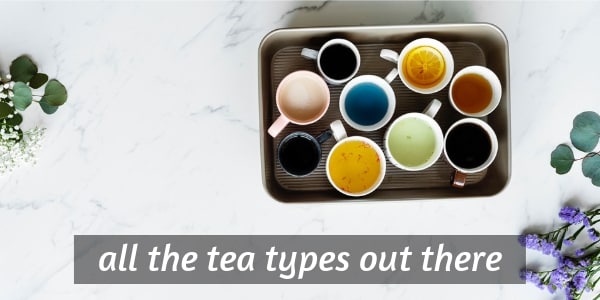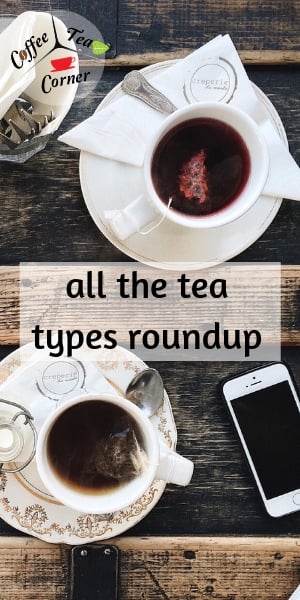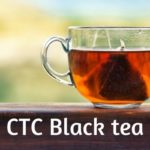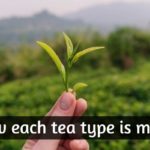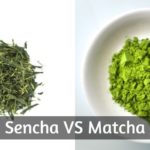If you're looking for a roundup of all the tea types in the world, you've found it. We'll take a look at all the tea types available in the world, and also what they taste like.
The distinction between true teas and tisanes will come into play here as well. True teas are those made of the Camellia sinensis or Camellia Assamica plant. Tisanes are any other tea, like herbal tea, or spice tea, and others we'll talk about today.
Table of Contents
1. Green tea is arguably the most famous tea
Starting with the most famous and popular tea, at least nowadays. Green tea has entered the West several centuries ago, but it's only been highly praised the past few decades for its health benefits.
Green tea is a true tea, made of the Camellia sinensis plant. This is the original plant that was used for tea in china, thousands of years ago. You might find Assamica green tea as well, though its rare. It's usually used for a type of black tea.
Green tea is made with the younger tea leaves, which are then left to dry for a bit, and pan-fired to keep them from oxidizing further. They can also be oven baker, or slightly roasted close to an open fire.
The Japanese method is to steam the leaves and then dry them. This allows for a greener brew, and gives the tea a slightly different taste.
Not all green tea brews end up pale green. The teas where the leaves were pan-seared, or baked, or brought close to a fire are going to give a pale yellow color instead, with not much green showing through.
You'll find green tea in many shops, supermarkets, tea houses and homes. Even the shadiest establishments carry some form of green tea, as it's a very sought after tea.
Not necessarily because of flavor. The flavor of a pure green tea, blended with nothing else, is a very astringent one.
This tea tastes very green, reminiscent of a zucchini, or a cucumber without the watery or extra refreshing taste of cucumbers.
You can sometimes detect green grapes, or a flowery note. Scalding this tea will make it very, very bitter.
Adding milk or steamed milk will ruin the flavor, and not make it any better. The green tea or matcha lattes available out there are masking the true taste of a green tea, rather than enhancing it.
But in general, green tea is a taste you have to get used to. It's not something many people can immediately open up to. This is why you will find so, so many green teas blended with several other flavors.
For example green tea with mango and pineapple happens to be one of my all-time favorite teas. The fruit lifts the entire drink, and makes everything right.
You'll also find green tea in simpler, more traditional forms. Like green tea with jasmine, or green tea with some strong mint in it as well. Even adding a bit of lemon zest completely changes the taste of the green tea.
1.2. Matcha is a specialized type of green tea
Matcha is a form of green tea, but it deserves a mention of its own.
This is powdered green tea, made of the youngest and best tea leaves available. The leaves used for Matcha are plucked from tea plants grown exclusively in the shade and very well tended to. Their leaves are steamed, dried, and de-veined to avoid any odd flavors.
This is because once the leaves are dried, they will be ground up into a very fine powder. Any stems or veins will remain larger, and thus affect the taste and texture of the final brew.
Sometimes the leaves aren't de-veined, but simply left whole. This results in a Gyokuro tea, which actually does produce a pale green brew.
Back to Matcha, this tea powder is meant to be thoroughly whisked into a very small bowl of hot water, and served immediately. This isn't an infusion, but rather a suspension.
A frothy, bright green drink that's going to taste much stronger than any green tea you've ever had. No bitterness is present, and the algae-like taste is more pronounced.
This is a more expensive type of green tea, and it's usually meant for special ceremonies or events. It requires its own tea set and utensils, but the result is always worth it.
2. Black tea is just as ancient and revered as green tea
Black tea is another beautiful tea, also a true tea. It's sometimes made of the Camellia sinensis plant, and that's when it's a true Chinese tea.
Other times, it's made of the Assamica version of the tea plant, and that is an Indian black tea.
for both versions the leaves used are older than the ones used for green tea, and they're picked a bit later in the season.
The point is, black tea is a bit less famous than green tea for its health benefits. However they're very close indeed, and black tea has been present and loved in the West for much longer than green tea.
Possibly because of the British, possibly because it's so reminiscent of coffee that many people took it up easier than green tea.
That being said, there are many variations of black tea. Like green tea, it too is often blended with spices, fruits, and flowers or other herbs to achieve a different taste.
Possibly the most famous is the Earl Grey version, with black tea perfumed with bergamot oil (a type of citrus). It's a very common tea nowadays, and many people have come to love it.
What about the taste of the original black tea, pure and simple ? It's a very malty, earthy taste. If brewed wrong or for too long, it can even take on an unpleasant, vegetal taste.
There are a few types of black tea, better explained here. These teas have a bit of difference in taste, but they all produce a malty, deep flavor. And all black teas take milk and sugar very well, especially if you brew them stronger.
There is a bit of a misunderstanding when talking about black tea in the East. They call black tea red tea these, referring to the color of the drink. The West calls black tea black, referring to the color of the leaves.
The West calls rooibos tea red tea, which the East simply calls rooibos. If you're not careful you could be buying a different tea, so always make sure you establish if everyone agrees on what is black tea in that discussion.
Of course, another kind of black tea you'll find is breakfast tea. Sometimes it doesn't even mention that it contains black tea, since it's been a commonly known fact for a long time.
Still, the first time I saw a box of breakfast tea I was very curious what makes something a breakfast tea, and what it's made of. After brewing a cup I found out it's black tea, and always just pure black tea.
It's the tea many brits use as their morning brew. Or, they used to. Apparently even they are turning over to the coffee side. Oh my.
Read Also: Is Green Tea Herbal Tea ?
3. White tea is a less known tea, more delicate
Another type of true tea, white tea is named so because of the tiny white hairs present on the leaf buds used for this tea. This is a very pale brew, and often on the more expensive end of the spectrum.
This is because the young buds used are more difficult to pick than the young leaves meant for green tea. Another reason is this is a tea that's a bit harder to process and keep well.
In some types of white tea, you'll notice the little silver hairs floating about in your cup. They're harmless and they're actually prized. The white teas that manage to do this are more expensive as well.
As for flavor, white tea is definitely not a beginner's tea. It a more subdued, delicate, floral aroma than green tea. It can taste too watery if you expect a strong, definite taste.
For example if you've had coffee and then drink a bit of white tea, it will taste much like water. You'll need a clean palate before you taste this kind of tea.
And, as with all teas it takes some getting used to. The flavor profile of the white tea is more subdues than green or lack, and at first you might not notice the notes in your tea.
Of course, there are flavored white teas out there, though the more traditional ones are pure white teas.
4. Oolong tea is the middle ground between green and black tea
Oolong teas are even less known in the West than green teas. These are made from the same leaves as green tea, only they're left to oxidize for a bit longer, and they're toasted for longer as well.
They're almost as processed as black tea leaves, only they're green tea leaves. These too are true teas.
The oolong tea is continuously processed, bruised, baked a bit more, and then bruised some more, until it's finally rolled into tiny ball shapes. Sometimes they're not little ball, but rather twisted into a longer form.
They both unfurl once you add hot water over them, and oolong tea requires more steeps than usual teas. White you can reuse green tea leaves for a second brewing, oolongs can yield even 4 steeps.
Oolong teas have a wide flavor variety, and they can have very different tastes according to what the tea master was aiming for. Therefore they don't have a general flavor profile like black tea for example.
But, oolong teas are made of the same leaves as green tea. They retain very little of the green taste, not tasting like algae or zucchini at all. But they're not black-tea either. They're a lighter taste, and one of the most wonderful oolongs I've had was a Milky Oolong.
Those are leaves that have been lightly smoked, and the leaves themselves produce a milk-like taste as well. This results in an initially confusing drink, and you're not sure if you're drinking high-fat milk or tea.
For me it was one of the best tea experiences.
(If you like this article so far, you can pin it to your Pinterest board by clicking the image below. The article continues after the image.)
5. Pu'er tea is a fermented brick of tea, meant to be aged for years
The final true tea we have on this list is the Pu'er tea. If understanding oolong tea flavor was a bit of a chore, then Pu'er is going to kick our butts.
Pu'er is made, again, from the same leaves as green tea. It was a sort of accidental discovery. Back when the Silk Road was still in use, the trip from China to Europe took a very long time.
Tea was something Europe always asked for, and China obliged. Only the length of the trip, along with the heat, and how compressed the tea leaves became on their way to Europe turned them into something else entirely.
So they became a new form of tea, the Pu'er.
Pu'er tea is meant to be aged, for as long as you have patience. Some are aged months, some for years. Think of it like a fine wine.
As the tea ages and ferments, the flavor will change and evolve. Therefore there is no clear way to explain what Pu'er tea tastes like, since it's an ever-changing taste.
When you buy Pu-er, it comes in brick form. The leaves are compressed and tightly wrapped, with a small amount of airflow. You can further age your Pu'er if you like, at home.
This too is a more expensive sort of tea.
6. Herbal tea is every other tea that's not a true tea
The only kind of tea on this list that's not a true tea. Actually any other kind of brew that's not made of tea leaves is a tisane.
So tisanes are herbal teas, and here we have every plant, flower, fruit, spice, and pine buds present in the world.
The taste of a tisane will be according to whatever you use to make it. A mint and lemon tisane will taste like, well, min and a bit of lemon zest.
Rooibos tea is here as well, since it's not a true tea. Rooibos is very famous, but it's made of a bush from South Africa. It contains no caffeine, and has its own, pleasantly sweet and caramel-like flavor.
Tisanes or herbal teas are freely found in every kind of shop possible. A strawberry tea is a tisane. A valerian root and lavender brew is a tisane as well.
The thing about tisanes is that they became popular for their perceived effects on the human body, many of them used in traditional medicine, like chamomile tea for example.
A few tea derivatives that are worth mentioning
There are a couple of brews that are teas, true teas, but then they're also not. This is mostly because of the other ingredients they have, and one of them is fermented.
So let's take a look at them.
1. Chai tea is a form of blended spices, sometimes containing tea leaves or herbs
Chai tea is actually a very old form of tea, Indian tea to be exact. It was around even before the British brought tea to India.
So Chai was meant as a blend of spices that help heal the body, including star anise, cardamom, cinnamon, black pepper, and cloves. To these various herbs would be added.
In later years black tea leaves were used in place of herbs, along with the spices.
That being said, Chai tea is going to differ from region to region and family to family. Each has their own recipe for what spices to add, and how many of each type, and whether tea leaves are used or not, and if herbs are added or not.
Now that I think about it, I did have one of these a few years ago. It was actually a black tea I brought for my mother, and then she forgot it in the back of the pantry for a few years.
The tea I bought was labeled as black tea, with added spices. But wouldn't it it a Chai tea, with black tea leaves ? I'll leave that up to you.
Just know that most Chais have those 5 spices added, and thus have a certain flavor profile.
2. Kombucha is a drink made of fermented tea, and a bit of yeast
Not to be confused with Konbu-cha, the Japanese kelp tea, which is a form of herbal tea.
So Kombucha is made of green or black tea, with some yeast and sugar added to it. It will ferment and produce a bubbly, slightly alcoholic drink.
It's easy to make at home, though you need to have a good yeast when you do this.
It's very reminiscent of elderflower drink, which is fairly common in East Europe.
Back to Kombucha, it's meant to be enjoyed cold, on a hot summer's day. The yeast imparts a nice, malty flavor to the drink, and if you use black tea leaves this will make it an even deeper flavor.
Of course, you can always flavor it with some fruit or spices as well.
Kombucha seems to be a very popular drink precisely because of the yuck factor it has. The yeast colony is meant to bring probiotics, which is something also found in pickles, and pickle juice.
I'm talking about the brine-based pickling method, and not the vinegar one.

Why some are called true teas, and some are called tisanes
This is mostly done to better differentiate between the two tea types. It also serves as a sort of guideline to know what to expect from your drink.
If it's a true tea, then it will contain caffeine, a high amount of antioxidants, and a strong taste. Consuming it in high amounts can be seen as a healthy habit, especially if no sugar or other sweeteners are added.
Tisanes are any other infusion that are not true teas. Like mint tea, lemon tea, forest fruit tea, and so on.
Tisanes contain no caffeine, unless it has been added and this needs to be specified on the label of the tisane.
Of course, some people can go a bit overboard with this classification and claim that tisanes are inferior, or that they're worthless when compared to true teas.
While tisanes have fewer health benefits than true teas, they are both useful and have a respected place in any home.
Only true teas contain caffeine
Of all the tea types out there, white tea contains the most caffeine. This is because the youngest parts of the tea plant are the ones that contain the most caffeine.
So white tea has the most caffeine, then comes green tea, where the leaves are young. After that black tea has slightly less caffeine, since it uses slightly older leaves.
The differences aren't ground-breaking, but they're there. You'll find some black teas using a few tea buds as well, and those will have more caffeine than usual black tea.
None of these teas will give you a kick like a cup of coffee, because the caffeine in tea works differently than the one in coffee. More on that can be found here, but in short the L-theanine in tea binds with caffeine and makes it a gentler, slower energy release.
Final thoughts
There are many kinds of teas out there, and if we actually stopped to count every possible tea blend out there, we'd run out of time.
But these are the 6 main tea types out there, along with the two honorable mentions of Chai and Kombucha. If your favorite tea hasn't been mentioned, take another look at the categories, because it's bound to be one of those types.
For example if you've got a Lapsang Souchong, you'll know that's a smoked black tea, and thus belong to black teas. If you have a White Peony, that's a white tea.
If you want to know more about coffee or tea, feel free to check the related articles below. Who knows what else you might find ?

